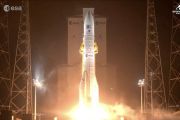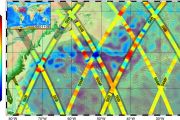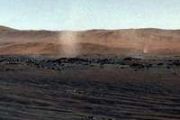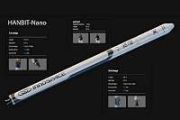
Copernical Team
NASA to demonstrate laser communications from Space Station
 NASA uses the International Space Station - a football field-sized spacecraft orbiting Earth - to learn more about living and working in space. For over 20 years, the space station has provided a unique platform for investigation and research in areas like biology, technology, agriculture, and more. It serves as a home for astronauts conducting experiments, including advancing NASA's space commu
NASA uses the International Space Station - a football field-sized spacecraft orbiting Earth - to learn more about living and working in space. For over 20 years, the space station has provided a unique platform for investigation and research in areas like biology, technology, agriculture, and more. It serves as a home for astronauts conducting experiments, including advancing NASA's space commu Station Hosts 11 Crewmates from Five Countries
 Eleven astronauts and cosmonauts are living together aboard the International Space Station following the arrival of the SpaceX Crew-7 mission on Sunday. While the new crewmates get adapted to life in microgravity another crew is preparing for its departure this weekend.
The orbital outpost's newest crew of four, representing the U.S., Denmark, Japan, and Russia, arrived on Sunday aboard t
Eleven astronauts and cosmonauts are living together aboard the International Space Station following the arrival of the SpaceX Crew-7 mission on Sunday. While the new crewmates get adapted to life in microgravity another crew is preparing for its departure this weekend.
The orbital outpost's newest crew of four, representing the U.S., Denmark, Japan, and Russia, arrived on Sunday aboard t Kremlin vows to pursue Moon race after Luna-25 crash
 The Kremlin said Tuesday that Russia would not give up its ambitions to land a craft on the Moon after its first lunar mission in nearly 50 years failed this month.
The Luna-25 module crashed on the Moon's surface after an incident during pre-landing manoeuvres. An Indian mission days later successfully landed near the Moon's south pole.
"We know that the way to the stars is through thor
The Kremlin said Tuesday that Russia would not give up its ambitions to land a craft on the Moon after its first lunar mission in nearly 50 years failed this month.
The Luna-25 module crashed on the Moon's surface after an incident during pre-landing manoeuvres. An Indian mission days later successfully landed near the Moon's south pole.
"We know that the way to the stars is through thor Scientists zoom in on the Asian monsoon season using satellite data
 Scientists from Tokyo Metropolitan University and other institutes have studied new satellite data showing the diameter of rain droplets and the distribution of heavy ice in the atmosphere worldwide. They focused on the Asian monsoon region, finding larger droplets and more heavy ice precipitation on land before the actual monsoon season. Their findings shed new light on the features of the pre-
Scientists from Tokyo Metropolitan University and other institutes have studied new satellite data showing the diameter of rain droplets and the distribution of heavy ice in the atmosphere worldwide. They focused on the Asian monsoon region, finding larger droplets and more heavy ice precipitation on land before the actual monsoon season. Their findings shed new light on the features of the pre- PAR Government shares in $900M Space Force contract
 PAR Technology Corporation (NYSE: PAR) reports that its wholly owned subsidiary PAR Government Systems Corporation, in close partnership with ICEYE US, the leading commercial provider of space-based radar capabilities, has signed a prime contract award for the Proliferated Low Earth Orbit (PLEO) Satellite-Based Services initiative led by the U.S. Space Force.
The contract serves as a mecha
PAR Technology Corporation (NYSE: PAR) reports that its wholly owned subsidiary PAR Government Systems Corporation, in close partnership with ICEYE US, the leading commercial provider of space-based radar capabilities, has signed a prime contract award for the Proliferated Low Earth Orbit (PLEO) Satellite-Based Services initiative led by the U.S. Space Force.
The contract serves as a mecha Viasat provides status update on Inmarsat-6 F2
 Viasat Inc. (NASDAQ: VSAT) has confirmed that its Inmarsat-6 F2 (I6 F2) satellite, which was launched on February 18, 2023, has suffered a power subsystem anomaly during its orbit raising phase.
At this stage, Viasat and Airbus, the satellite's manufacturer, are working to determine the root cause of the anomaly and assess whether the satellite will be able to perform its mission. Airbus h
Viasat Inc. (NASDAQ: VSAT) has confirmed that its Inmarsat-6 F2 (I6 F2) satellite, which was launched on February 18, 2023, has suffered a power subsystem anomaly during its orbit raising phase.
At this stage, Viasat and Airbus, the satellite's manufacturer, are working to determine the root cause of the anomaly and assess whether the satellite will be able to perform its mission. Airbus h Russia fails to restart space exporation program, eyes Chinese cooperation
 This week, the Russian space agency Roscosmos had hoped to return to the Moon after an absence of nearly 50 years. Instead, on Saturday it lost control of its Luna-25 lander. The agency explained the spacecraft "switched to an off-design orbit and ceased to exist as a result of a collision with the lunar surface".
Yet, in an interview aired on state television, the agency's chief, Yuri Bor
This week, the Russian space agency Roscosmos had hoped to return to the Moon after an absence of nearly 50 years. Instead, on Saturday it lost control of its Luna-25 lander. The agency explained the spacecraft "switched to an off-design orbit and ceased to exist as a result of a collision with the lunar surface".
Yet, in an interview aired on state television, the agency's chief, Yuri Bor PILOTing through the magnetosphere: Using mission design to advance science
 Not so long ago (2022), Advanced Space collaborated with a team of science and engineering organizations to help design a science mission to study the effects of the biggest space weather maker in the solar system: the Sun. The mission concept, called Plasma Imaging, LOcal measurement, and Tomographic experiment (PILOT), is designed to measure the flow of cold, dense plasma into and out of Earth
Not so long ago (2022), Advanced Space collaborated with a team of science and engineering organizations to help design a science mission to study the effects of the biggest space weather maker in the solar system: the Sun. The mission concept, called Plasma Imaging, LOcal measurement, and Tomographic experiment (PILOT), is designed to measure the flow of cold, dense plasma into and out of Earth NASA's TEMPO sends first North American pollution data maps
 The first data maps from a NASA pollution-monitoring instrument were released Thursday. NASA's TEMPO device creates visual representations of pollution and air quality over North America from 22,000 miles above the equator.
"Neighborhoods and communities across the country will benefit from TEMPO's game-changing data for decades to come," NASA Administrator Bill Nelson said in a stateme
The first data maps from a NASA pollution-monitoring instrument were released Thursday. NASA's TEMPO device creates visual representations of pollution and air quality over North America from 22,000 miles above the equator.
"Neighborhoods and communities across the country will benefit from TEMPO's game-changing data for decades to come," NASA Administrator Bill Nelson said in a stateme Lockheed Martin to supply 36 Small Satellites to advance SDA satcom network
 The Space Development Agency (SDA) awarded Lockheed Martin (NYSE: LMT) a firm-fixed price agreement valued at approximately $816 million to build 36 Tranche 2 Transport Layer (T2TL) Beta satellites. T2TL is part of an overarching plan to strengthen deterrence with more resilient space architectures for beyond line-of-sight (BLOS) targeting, data transport, and advanced missile detection and trac
The Space Development Agency (SDA) awarded Lockheed Martin (NYSE: LMT) a firm-fixed price agreement valued at approximately $816 million to build 36 Tranche 2 Transport Layer (T2TL) Beta satellites. T2TL is part of an overarching plan to strengthen deterrence with more resilient space architectures for beyond line-of-sight (BLOS) targeting, data transport, and advanced missile detection and trac 



























